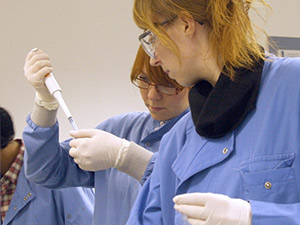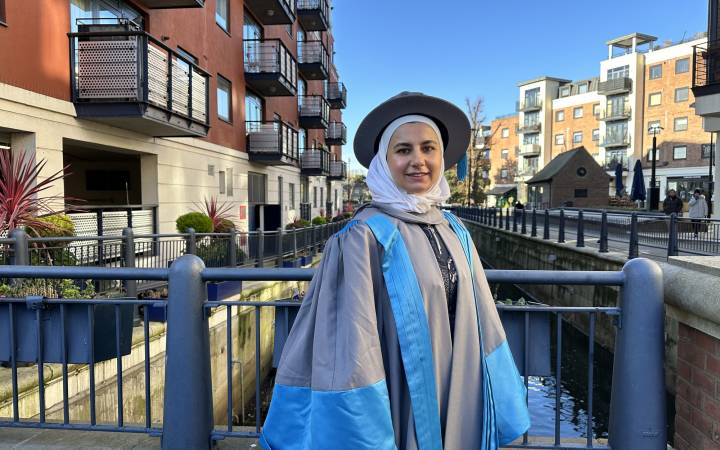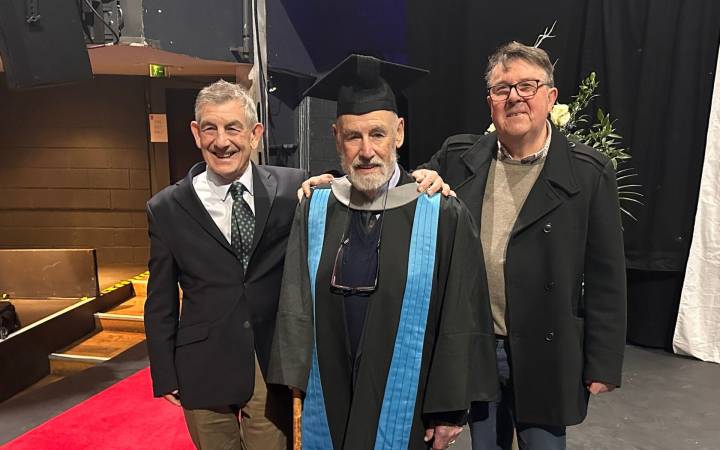Women in science – Penny Holliday
Posted Monday 9 June 2014
 Each week we bring you a profile of a Kingston alumna who has contributed greatly to the field of science.
Each week we bring you a profile of a Kingston alumna who has contributed greatly to the field of science.
This week we find out about Penny Holliday, who graduated in 1988 with a first-class Geological Sciences BSc(Hons). She is currently a senior physical oceanographer at the National Oceanography Centre.
How did you first become interested in science?
My natural curiosity about the shape of the world around me and how it came to be the way it is, was encouraged by a geography teacher who taught us how to interpret the landscape we saw. To see the way in which geology influences everything from the colour of the soil, the shape of the horizon, the plants you walk among, the places that towns and cities grow, to the kind of jobs that have developed in your local area, was an incredibly exciting discovery to me.
As a teenager I loved the way I could uncover hidden truths and past histories by being a landscape detective.
What did you do after leaving Kingston?
I left Kingston in 1988 when there was a shortage of graduate jobs in all disciplines. Disappointingly I found that having a first-class degree excluded me from some attractive jobs such as working for the National Rivers Authority – I was told I was "over-qualified".
So for a couple of years I worked in shops and factories while I continued to apply for career positions. In 1990 I was offered a position as a scientific administrator in the Institute of Oceanographic Sciences, Deacon Laboratory, a research centre funded by the Natural Environment Research Council, UK. I worked in an office that co-ordinated a multi-national oceanographic programme that set out to measure the global ocean circulation during a five-year period.
The job included lots of travel for project meetings in the 32 different countries taking part. In 1995 I started work on a part-time PhD in oceanography so that I could expand my work from project management to scientific research. From 1995 to 2002 I worked half time as a research scientist, and half time in the co-ordination office. I gained my PhD in 2002 and after that I devoted all my working time to research, my main interest being the circulation of the North Atlantic Ocean. My place of work is now the National Oceanography Centre in Southampton.
What's it like being a woman in the scientific workplace?
The world of science is a fantastic place to work – it's exciting, ever-changing, intellectually stimulating, full of interesting people, and in oceanography there are many opportunities to travel to unusual and exciting places. This is true whether you are female or male. But there are some additional challenges that women face, including a tendency to be overlooked for career-enhancing opportunities such as conference keynote talks and international committee membership. To counter this, women need to be confident enough to stand up and make their voices heard, something many women find hard to do. In ocean sciences there are still too few senior female role models for young women.
Can you tell us any quirky or unusual experiences from your career?
In February 2000 I was principal scientist on a research ship in the North Atlantic ocean, and we experienced nine days of terrible storms in which we recorded the biggest open ocean waves ever measured – as much as 30m from peak to trough. The ship suffered some damage, people were hurt as they fell during the severe rolling of the ship, and there was no hope of achieving any of the scientific objectives of the research cruise. But the story has proved a popular one, making an excellent salty-old-sea-dog story on subsequent research cruises, being featured in best-selling books, TV programmes and many newspaper and magazine articles. I wrote a journal article about the physics of the waves, and I still get requests for interviews from journalists, and the occasional emails from school children asking about waves and climate change.
In December 2012 I was on a research cruise in the Southern Ocean when my travel plans fell through, and instead of flying straight home from a UK base on the Antarctic peninsula, I had to stay on the Royal Research Ship James Clark Ross for an extra three weeks. The ship provides logistical support to research bases all around the Antarctic peninsula so myself and the other all-women team of scientists embarked on a fabulous tour. We were lucky enough to climb into a ice-sheet crevasse at Rothera, go ashore on a RIB in wild, windy and snowy conditions at Port Lockroy, help with loading and unloading boxes and people at Signy, Jubany and Bird Island, and to bathe in hot thermal springs at an abandoned whaling station in Deception Island. This involved stripping off our bulky Antarctic outerwear and lying in our undies in a few inches of bath-warm water, in air temperatures below freezing, admiring the snow and ice on the hills of the caldera around us and the penguins walking by. It was hard to adjust to normal life at home after that trip!
What's a typical day like?
Every day is different as the lab handles such a diverse range of samples. A typical week could see me analysing heroin and cocaine, soft fruit extracts, dead jellyfish and whisky. Then the next week could be pumpkin seed oil samples, human tissue samples and a selection of Viagra tablets. Certainly never a dull moment.
How can society encourage more women into science?
By showing girls and young women that it's normal to do so, allowing them to imagine themselves in those careers. Role models need to include the very high-fliers to raise ambitions, but they also need to include successful senior women who lead normal lives with families, school-runs and trips to the supermarket. I'm one of those women – I've had some very exciting adventures, but I've worked part-time for the past 11 years so that I can spend time with my children.
How easy is it to get back in after a career break?
I was lucky to have already secured an open-ended position by the time I had my two periods of maternity leave (six and nine months). In both instances it was easy to get back into work after those breaks, and my employer has allowed me to work the hours that suit me.
If you have children, would you encourage them to follow a career in science and technology and do you think scientific talent is based on nature or nurture?
Yes, I would encourage anyone to follow a career in science and technology because it can be incredibly rewarding. Both my children are interested in science and technology, although to them it's called designing Lego creations, or wondering why they hear an aeroplane after they have watched it fly by. It's hard to know whether they have inherited this tendency, or whether it's because their parents talk about these kinds of things at home and have explanations that lead to more questions. For my daughter this interest can sometimes set her apart from her peers because "normal" interests for girls in our society are more heavily steered towards being famous, or wearing the right clothes, or training for caring roles. For my son it seems more normal because it fits within the acceptable "boys' toys" of construction and science. The gender-discrimination in present-day toy shops is a particularly damaging form of nurture.
Are there certain skills which women can offer in the science and technology world compared to men?
The world of science needs a range of skills and personalities that can be found in women and men. I don't believe that there are any particular skills that can be found more generically in one gender or the other.
How well paid is a science career?
A science career has provided me with a reasonable but not a high salary. Recent government policy has meant that my pay has steadily decreased for the past few years. For me, the rewards take a different form – a job which I look forward to coming to every day, flexibility of working hours, and a continuing sense of excitement and job satisfaction.



